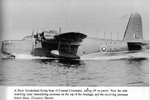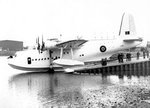Hobilar
Airman
The Short S.25 Sunderland, in spite of being one of the last flying-boats designed, was durable enough to remain in service for some twenty-one years, and is generally considered to have been one of the finest flying boats ever built.
To meet the requirements of the Air Ministry Specification R.2/33 Short's Chief Designer, Arthur (later Sir Arthur) George, prepared a tender which was submitted to the Ministry in 1934. The Design was based on the Company's C Class "Empire" flying boats which had been operated by Imperial Airways in the 1930s. The Air Ministry, already sufficiently familiar with the aircraft's civilian counterpart, accepted the proposal and placed an order in March of 1936, a full eighteen months before the prototype (K4774) made its maiden flight (16 October 1937). Deliveries to the Royal Air Force began in June 1938 with the first batch of production Sunderland Mk Is being delivered to No.230 Squadron based in Singapore. These Sunderlands would replace the RAF's mixed fleet of biplane flying boats and represented a huge leap forward in capability.
Initially two squadrons were equipped with the Sunderland Mk.1 during 1938, but by the outbreak of war in the following year a further two squadrons had converted to the type (with a further three being formed within the opening months of the war). Sunderland 1 production would eventually total 90 machines (15 of which were built by the Blackburn Aircraft Company). These first machines were powered by four 1,010 hp Bristol Pegasus XXII radial engines.



